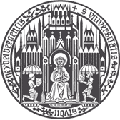Chaotically Singular Spacetimes
Course at Universität Heidelberg
Fall Term 2016
Lecturer
Eugene Trubowitz,
Mathematik, ETH Zürich
Professor Trubowitz gives these lectures as a guest professor within the activities of the Partnership Mathematics-Physics at Heidelberg University.
Contents
One might have, more provocatively, entitled the course: How does time end (in Einstein's general relativity)?
More technically, what does a generic singular point, restricting time, in solutions to the Einstein gravitational field equations look like?
Special cosmological solutions, such as Freedman's, do have singularities.
In 1963, Lifshitz and Khalatnikov 'constructed a class' of singular solutions and concluded that '... the presence of a singularity in time is NOT a necessary property of cosmological models of the general theory of relativity, and that the general case of an arbitrary distribution of matter and gravitational field does not lead to the appearance of a singularity.'
In 1965 Penrose and Hawking formulated and proved 'incompleteness' theorems that convinced even Lifshitz and Khalatnikov that singularities in time are a necessary property of cosmological models of the general theory of relativity. Penrose and Hawking proved, that under very general, physically reasonable conditions, a spacetime (that is, a solution to the Einstein equations) has a light ray (null geodesic) that suddenly ends ('incompleteness') sufficiently far in the past. They adroitly sidestep the problem of defining what a singularity actually is, by saying it is the 'place' where their light rays end. The proofs of these incompleteness theorems are non-constructive and provide no quantitative information about what a 'singularity' really looks like.
In 1970, Belinskii, Khalatnikov and Lifshitz revisited the work of 1963 and found that Khalatnikov and Lifshitz had missed something and that '... we shall show that there exists a general solution which exhibits a physical singularity with respect to time.' In 1982 they revised the 1970 proposal. Their work culminates in a series of fascinating, but very heuristic, statements about the possible existence of a class of singular solutions to the field equations. These heuristic statements are referred to as the 'BKL Conjectures'.
In this course, we will rigorously formulate and prove the 'BKL Conjectures' for homogeneous spacetimes. That is, we will construct a set of initial data with positive measure which evolve into homogeneous, chaotically singular spacetimes that exhibit all of the BKL phenomenology. Most importantly, there are chaotic oscillations, growing in magnitude, whose distribution is governed by the continued fraction expansion of a parameter appearing in the initial data.
The lectures will be completely self-contained. One doesn't need to know anything about general relativity; the Einstein field equations will be introduced from scratch. We will classify real, three dimensional Lie algebras, introduce tensor analysis and discuss the geometry of homogeneneous spacetimes. We will also derive the basic properties of continued fractions and the Gauss map.
Prerequisites
Analysis and linear algebra.
Format
Lectures and discussion sessions. Details will be given in the first lecture.
Literature and exam modalities
will be announced in the lecture
Event coordinates
Tuesday 14-16, kleiner Hörsaal
Wednesday 9-11, großer Hörsaal
Philosophenweg 12
First lecture: Wednesday, October 19, 2016





